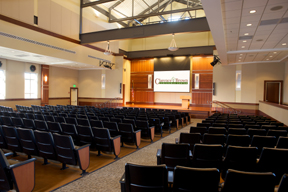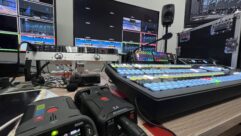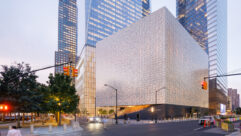
SVC Podcast – Show Notes – Show 132-2:
In this edition of the SVC Podcast, SVC Contributing Editor Bennett Liles continues his talk with Mark Cray, the CEO of AGT, on the company’s total digital upgrade for the Clarence Brown Conference Center in Cartersville, Georgia. Mark discusses how the project got started and he outlines the steps in the large project. He also describes the video distribution methods and provides details on the sound systems and their capabilities. System testing and initial shakedown are also covered.
Links of interest:
- AGT – Applied Global Technologies, AV design and integration
- The Clarence Brown Conference Center
- 10.1in. Crestron Touch Screen
- 7in. Crestron Touch Screen
- Clarence Brown Conference Center: Analog to Digital Transition
Download Podcast Here:
https://s3.amazonaws.com/nb-svc/public/public/132-2_Clarence_Brown_Conf_…
From Sound & Video Contractor Magazine, this is the SVC Podcast with Mark Cray of AGT. Show notes for the podcast are available on the web site of Sound & Video Contractor Magazine at svconline.com.
The Clarence Brown Conference Center needed to upgrade their entire AV operation for a ballroom, meeting venues and an executive boardroom. AGT brought in Crestron’s DigitalMedia and AirMedia and CEO Mark Cray is back with us to finish his story on how all that got done under the deadline. That’s coming up next on the SVC Podcast.
Mark, thanks for being back with us for Part 2 on the SVC Podcast from AGT and we’re talking about the Clarence Brown Conference Center digital upgrade that you did. We talked in Part 1 about the different rooms that were done, including the Etowah Ballroom, Carter Hall, Stilesboro Hall and the Executive Boardroom. On Part 2 I wanted to get more into the mechanics of it. So you got the project, they called you in. What was the first thing you did? How did you get the ball rolling on this one?
Yeah, pretty much the way we start all of our projects is in a very consultative fashion. So we went onsite and met with them and we did an evaluation of all the equipment that they had. We listened to their needs and their pain points and then we also listened to what their objectives were and then kind of tried to flesh out maybe some future goals as well. Then of course we kind of had to take into consideration as well what their budget was. So as we typically do in those cases is we really scope out the existing environment and listen to them and then we come back and we design a solution for them and then present it. And then we usually have probably a few meetings going back and forth to really kind of fine tune the design. So this engagement with Clarence Brown was pretty much like all the others that we work with; a lot in that same fashion. One of the things that’s probably a little different with Clarence Brown was again, as I think I alluded to in Part 1, is they had currently a lot of issues with system reliability, user interfaces not being too easy and also just some unhappiness with the maintenance services that they were getting from their service provider. So we really had to make sure that we crafted and designed a really good intuitive system, but we also were able to put in a good support plan and training plan that would serve them days and days and years beyond the installation. [Timestamp: 2:42]
Yeah, that’s always the trick to it because some of the AV installations I’ve seen, they sort of wanted to impress everybody with the system’s complexity but you almost have to be a wizard to operate it. So the user friendliness plus the versatility needed for some of these places like the ballrooms that can be sub-divided, that gets kind of tricky and it can test what you really know about all of this stuff.
Mm-hmm. That’s for sure.
There were huge spaces like the ballroom and then much smaller areas like the Executive Boardroom so the systems probably weren’t identical but there are lots of displays involved and I was wondering how you get the video signals distributed to all of those displays. Is it done differently in the small rooms from the way you did it in the bigger areas?
Most all of them had large format screen displays and each of the screens had projectors. So the Carter Hall, which was the auditorium just had the single projector and the single screen whereas Stilesboro and the Etowah Ballroom had multiple displays and multiple screens. But pretty much in each of those cases we did the same things. We used the Crestron Digital Media to handle all the routing and then we used the Crestron control panels to allow the user or the administrator to control the routing as well. There was HDMI and VGA connectivity everywhere because as much as they needed to get their digital support they still had to have some backwards compatibility for the analog support. And then we also implemented the Crestron AirMedia solution which is a really nice solution that allows users to be able to present to the projection systems wirelessly. So that was kind of the design that we did for the video in each of the rooms and then like I said since a lot of those rooms like the Stilesboro Hall and the Etowah Ballroom were able to be room combined or broken up. We had a lot of intelligence in the way we wrote the program to be able to handle the routing. So again the users, instead of having to think about if they’re in a certain room configuration that might involve these three projectors so I’ve got to send video to these three projectors, they just kind of hit configuration mode three or whatever and the Crestron system did the work in terms of being able to route everything to the appropriate displays. [Timestamp: 4:55]
And I’m sure the input from the clients was valuable in determining what they needed or what they thought they needed and come up with the solution without having to configure every screen for every source.
Yeah. Yep.
I know this was a big job and it probably took a while but I was intrigued by the new system’s audio capabilities. In some of these places where you have variable seating and flexible room configuration that can affect the audio more than anything else.
Yeah, definitely. For the audio system we used Biamp audio and we used Shure wireless microphones. And then we also employed a multi-room audio checker to prevent audio stacking or doubling. So basically having the same source mixing into an output twice, which when you get into the room combinations that can be inadvertently a problem. So we made sure that we had a design that didn’t allow for any audio stacking or doubling. So much the same methodology we deployed in the video routing we did in the audio routing which was build as much intelligence into the system as we could and put that in a format to the user that was really intuitive and easy for them to understand so they don’t need to understand when they push this button all this stuff happens; it just happens and they can have confidence that the room is going to operate as they expect it to. [Timestamp: 6:12]
And very user friendly to help prevent getting a lot of calls but sometimes they need some assistance anyway so when those situations come up, how do they get the help they need?
We have a help desk that has around-the-clock service so users can either call via phone, they can email, they can live chat with any one of our help desk professionals and then we can easily make some kind of fix remotely or even go onsite if we need to do that to help them out. They’ve got, at Clarence Brown, some system administrators who understand the operation of the system so we made sure that we really spent some time training them as best as we could in addition to having really intuitive interfaces and were able to offer their smart, hands-on people maybe a little higher technical level support. So any time they need help our phone numbers and emails are posted. They’re able to call us and get immediate support. [Timestamp: 7:06]
Now when you’ve got a system that can be modified for different room configurations like Stilesboro Hall I think it is, you don’t really put that in the hands of the client do you? I mean you probably put that under the tech guys’ control because they know the different configurations or do you actually turn it over to the clients?
Well, like in the Stilesboro Hall and the Etowah Hall, those actually share the same control room. So what we did there is we put a master control system in the control room for each of those rooms and a Clarence Brown administrator actually kind of makes the room configuration change on the touch panel. So a user can use their touch panel at their podium to maybe show something or play something or do something that the user would need to do, but we let the administrators back in the control room do all of the settings for changing over to one configuration or another. So we just kind of let the presenters kind of focus on anything they might need to do during their presentation. [Timestamp: 8:05]
So you got the project in and got everything connected. Obviously you have to test all of this so how long did the system testing and evaluation take? I know you had to be under a deadline for all this.
Yeah. All of our installs, we have a standard checklist that we require each of our technicians to do and then go through with the end customer, and this of course was no different although it was a much bigger and longer checklist. So I think all in we spent about four total days testing every room, every configuration, every scenario, every feature that you could imagine. We did that in about four days. We completed the checklist and we got acceptance from the folks over at Clarence Brown. And then what we did here, which was probably very unique, was we actually had a technician stay onsite for the first couple of days for their first couple of events just to make sure that they really understood how to use the system and if there was any kind of glitch or bug or something that may have been missed during our Q&A and checklist procedure we were able to fix it right onsite. But we kind of found when you have a good design, good equipment and good training and then you go away, when someone’s going to use it for the first time those are sometimes where some of the issues get exposed. So having somebody onsite there for those first couple of conferences is pretty key; 1. To give them the confidence to operate the system, and 2. Just to make sure if there is anything we didn’t catch during the testing that we get it exposed and get it corrected. [Timestamp: 9:35]
And you mentioned the control room. Is that also where all of the racks and support gear is installed?
Yes. Stilesboro Hall and Etowah Hall, they share a control room that has all the components going back to it. And then of course the auditorium, Carter Hall, had a control room that was basically kind of behind the stage. [Timestamp: 9:53]
Well, obviously that’s probably techie territory and not frequented by the clients I’m guessing.
No, not at all. Definitely not. It’s like The Wizard of Oz, the man behind the curtain. You don’t know what’s going on back there.
Right. They probably wouldn’t want to know even if they did know. So how do you normally future proof or make expandable a system like this. Do you just have a couple of extra inputs for sources that may come along later?
Yeah. Of course again, during the consultation phase we not only expose kind of what it is they need to do with the system, but we kind of also try to flesh out what they think they might want to do with it in terms of future upgrades. And then there’s always things you don’t know. So we do a couple of things: 1. We try to use good hardware from manufacturers like Crestron that today Clarence Brown is using video at 1080p, but maybe in a year or two years they need to do 4K, the control system already supports that. So it’s a combination of expandability, more inputs than outputs and just having the technology that will support maybe kind of the next couple standards that are coming. [Timestamp: 10:59]
Right. Just not painting yourself into a corner anywhere.
No, no.
All right. Well, this has been great listening to how you did all of this because I’ve seen the pictures of it and it really looks like a beautiful place and to combine that with the ease of operation on a fairly complex system I know is a challenge. I’m sure that you guys get a kick out of doing these things though and it’s fun to get the inside story on it. It’s Mark Cray with AGT and the big digital upgrade for the Clarence Brown Conference Center in Cartersville, Georgia. Thanks for telling us about this one.
Thanks for the opportunity to tell our story, Bennett.
Thank you for being here with us for the SVC Podcast with Mark Cray of AGT. Show notes are available on the website of Sound & Video Contractor Magazine at svconline.com. Join us again next time for the SVC Podcast.










